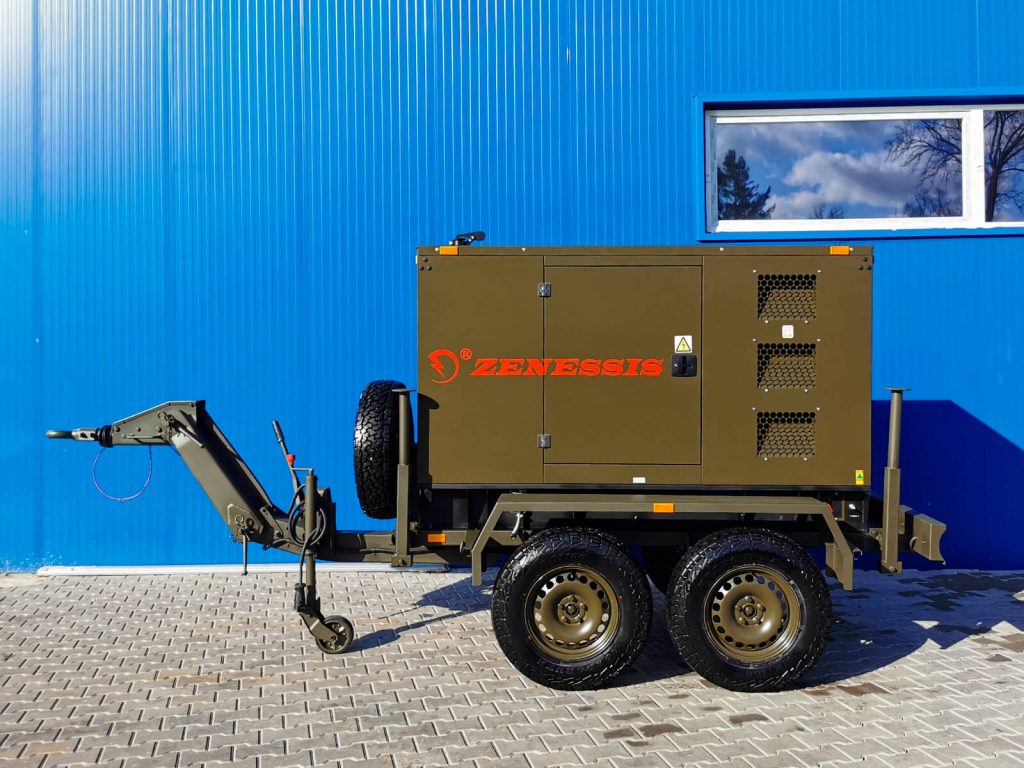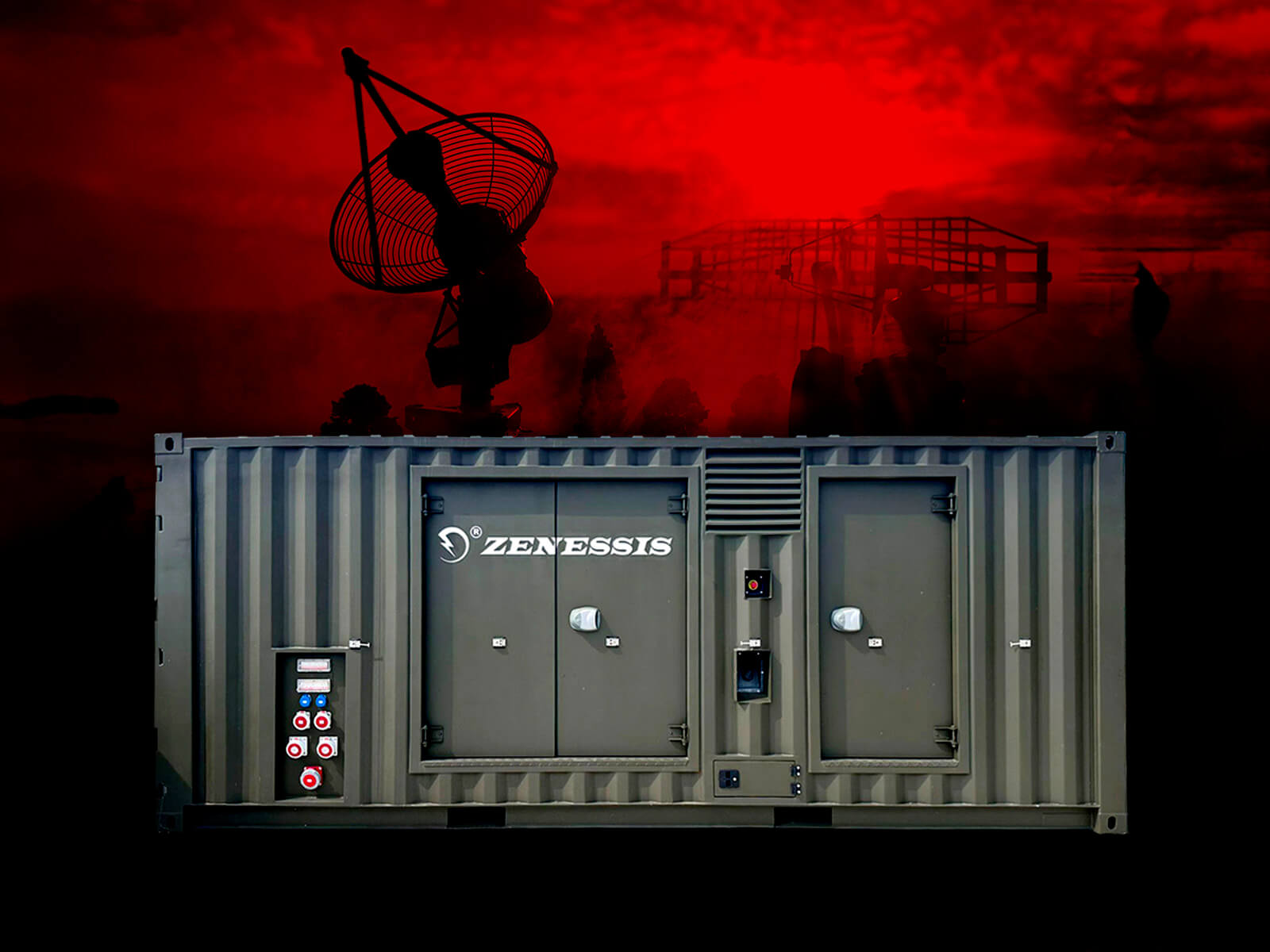Why Military Applications Require Dedicated Generators
In the defense sector, every technical decision has a direct impact on safety, mobility, and operational efficiency. Electrical power sources are essential in this ecosystem. That’s why generators used in military applications cannot be selected using standard criteria – they must be designed to meet specific and critical operational requirements.
Extreme Operational Environments and Strict Tactical Demands
Military generators must operate under radically different conditions compared to civilian ones:
- Remote or conflict zones without electrical infrastructure;
- Extreme temperatures (–30°C in alpine theaters, +50°C in desert regions);
- Constant exposure to shock, vibration, and high humidity;
- The need for silent operation to avoid detection.
In such conditions, the energy source becomes a critical element of survival and tactical mobility.
In an advanced base, a generator that starts on time can mean the difference between a successful communication and a dangerous mission disruption.
The Critical Role of Power Supply in Modern Military Missions
Nearly all military systems today – from communications and control to weapon systems and logistics – depend on electrical energy. Some vital applications include:
- Mobile command centers operating in conflict theaters – powering C4I systems (Command, Control, Communications, Computers, and Intelligence);
- Radar systems and reconnaissance sensors – requiring signal stability and filtering;
- Field medical installations – where constant power can mean life or death;
- Armored or tactical vehicles – where mobile generators ensure autonomy and support for auxiliary equipment.
These realities demand high standards of reliability, autonomy, electromagnetic compatibility, and most importantly, uncompromised mission performance.
What Differentiates a Military Generator from a Civilian One
At first glance, a generator is a generator – it produces electricity and gets the job done. But in military scenarios, “just working” is not enough. The differences between civilian and military-grade equipment become clear when conditions turn unpredictable, harsh, or hostile.
NATO Standards and Compatibility with Combat Equipment
Generators used in operational theaters must comply with standards such as:
- STANAG (Standardization Agreements) – for interoperability among NATO forces;
- EMC (Electromagnetic Compatibility) – ensuring no interference with nearby electronic systems, even in electronic warfare scenarios;
- EN ISO 8528 / EN 12601 – for reliability, safety, and performance stability.
In practice, this means a military generator must:
- Be compatible with mixed tactical electrical grids (50Hz/60Hz);
- Operate without interference to critical communications systems;
- Support rapid connection through standardized connectors.
Compatibility is not a luxury – it’s a guarantee that equipment will work seamlessly regardless of location or allied forces.
Electromagnetic Protection, Storm Resistance, and Shielding
Civilian generators aren’t built to withstand EMP attacks or sandstorms. Military generators, on the other hand:
- Feature electromagnetic shielding and EMI/EMC filters;
- Are built with reinforced, sealed enclosures to protect against weather, dust, and humidity;
- May include armor layers or special coatings to reduce radar or thermal signature.
These protections are essential for reconnaissance, communication, or any mission where being detected could mean mission failure.
Mobility, Autonomy, and Fast Start-up in Real Scenarios
A military generator must be:
- Mobile: towable, containerized, or vehicle-integrated;
- Autonomous: capable of running for hours without refueling or human intervention;
- rapid: pornire automată în mai puțin de 10 secunde, uneori chiar în paralel cu sistemele de backup.
🛠 Key features:
- Redundant start systems (electric + manual);
- Smart load management;
- Optional silent mode operation, critical for stealth missions.
Essential Requirements for Military Generators
A generator designed for military applications must be more than a simple power source: it must provide operational security, true autonomy, and adaptability to any field condition. Here are the most important requirements to consider.
Multiple Voltages, Mixed Frequencies, and Stability Under Variable Loads
Military systems connected to a generator can have varied electrical demands:
- 230V single-phase and 400V three-phase – simultaneously;
- Different frequencies: 50Hz in European NATO zones, 60Hz for international cooperation;
- Large load fluctuations, caused by starting communication systems, radar, or emergency refrigeration.
The generator must handle all of this without dangerous voltage variations and with an instantaneous response time. Electrical stability isn’t just a matter of convenience – it’s vital to protect expensive equipment and sensitive data.
✅ Recommended: Generators with high-precision AVR (Automatic Voltage Regulator) and active frequency adjustment capabilities.
Reliability in Continuous Operation – Even at Extreme Temperatures
Military generators cannot afford “downtime.” They must operate:
- In continuous mode (24/7),
- At –30°C or +50°C,
- To handle this, they require:
High-performance cooling systems adapted to the climate of operation;
- Advanced intake air and coolant filtration;
- Advanced filtration of intake air and coolant
- Self-diagnostic sensors and automatic protections against overheating or short-circuit.
If the generator fails during a critical mission, the entire operation is compromised. Reliability isn’t a benefit – it’s a requirement.
Integration with Communications, Weaponry, and Control Systems
A modern military generator must be compatible with:
- C4ISR systems (Command, Control, Communications, Computers, Intelligence, Surveillance, Reconnaissance);
- Encrypted communications networks;
- Tactical mobile IT systems and servers;
- Fire control systems, sensors, and radar devices.
This means the generator must have:
- Multiple individually protected outputs;
- EMC/EMI compatibility;
- RF filtering to prevent interference with critical communications.
🔌 Extra: Some models feature real-time monitoring ports, integration with energy management systems, and interfaces adapted to NATO standards.
What Types of Generators Deliver Performance in Military Scenarios
Military applications allow no compromises. Whether for a temporary forward base or a tactical vehicle in motion, the generator must provide stable power, immediate availability, and safe operation in the harshest conditions.
Zenessis delivers these capabilities through a range of industrially tested generators, built on Stage V platforms and adaptable to tactical environments.
Tactical Diesel Generators for Bases and Vehicles
Zenessis diesel generators equipped with Stage V-compliant engines are ideal for powering:
- Logistic bases;
- Mobile command centers;
- Containerized military vehicles.
🔋 Tactical Benefits:
- Stage V Engines: High efficiency and low emissions, meaning extended autonomy and minimal thermal footprint;
- Optional Silent Operation with advanced soundproofing – suitable for reconnaissance or sensitive communications operations;
- Modular Configuration: Can be mounted on trailers, armored containers, or integrated into special vehicles.
Zenessis diesel generators can be equipped with digital control panels featuring advanced monitoring functions, maintenance alerts, and remote diagnostics.
Mobile Containerized Solutions and Trailer-Mounted Generators
For rapid deployment missions, Zenessis offers containerized or military-trailer-mounted generators with features such as:
- Fast handling via forklift, crane, or hooklift;
- IP-sealed enclosures and anti-corrosion treatments;
- Multiple connection ports for simultaneously powering diverse equipment.
🔧 Customizable Options:
- Operation at –30°C/+55°C;
- Integration with radio stations, mobile servers, and radar equipment;
- Extended tanks for up to 48h autonomy without refueling.
Silent and Hybrid Generators for Discreet Operations

Special operations require a reduced acoustic footprint. Zenessis generators can be configured in versions:
- Super-silent, with noise levels below 60 dB at 7 meters;
- Hybrid technology, combining a diesel engine with Li-Ion batteries for silent operation in “stealth” mode.
🟢 Recommended Use Cases:
- Reconnaissance camps;
- Observation posts;
- Advanced command points;
- Vehicles with C4I equipment requiring noise-free and stable power.
Zenessis platforms are designed and manufactured in Romania, with adaptability to the requirements of the Ministry of National Defense (MApN) and full compliance with NATO standards, including relevant STANAGs.
How Zenessis Meets Defense Industry Requirements
Zenessis doesn’t build generic generators – it designs power solutions tailored to exact customer requirements. For military applications, this means full adaptation to field conditions, international NATO standards, and the specific needs of the Romanian Ministry of Defense.
Compliance with STANAG, EN, and MApN Internal Requirements
Zenessis generators can be configured to meet:
- STANAG – NATO interoperability standards on voltages, frequencies, connectors, and logistical integration;
- EN ISO 8528 – for performance, safety, and operational continuity;
- Military technical specifications issued by MApN units – including requirements for soundproofing, extreme temperature operation, and electromagnetic compatibility.
📌 Zenessis works directly with institutional customers to adapt equipment to real, not just theoretical, military specifications.
Customization by Theater of Operations: Climate, Altitude, Mobility
Military deployments vary widely, and Zenessis offers:
- Cooling systems for desert operation, with dust protection and forced ventilation;
- Low-temperature configurations for alpine or arctic zones, with oil preheaters and battery warmers;
- Containerized or trailer-mounted units for easy transport in mobile missions;
- Special anti-corrosion coatings for naval or humid environments;
- Quick tactical connectors integrated into the electric panels for instant connectivity.
All solutions are manufactured in Romania, with full control over production, testing, and adaptation – a major logistical and strategic advantage for institutional clients.
🛠 Project Examples:
- Silent diesel generators for mobile command centers;
- Containerized platforms powering campaign camps;
- Units adapted for mounting on communications or observation vehicles.
What to Look for When Choosing a Generator Supplier for Military Applications
Choosing a military generator is not just a transaction – it’s a strategic investment. It’s not enough to compare nominal power or price per kVA. The supplier must provide operational security, traceability, and long-term logistic support.
Real-World Testing, Traceability, and Included Maintenance
A serious supplier doesn’t just promise specs on paper. They offer:
- Demonstrations in simulated operational conditions – cold-start tests, load response, real noise level;
- Full traceability – from engine/generator origin to final assembly and test;
- Complete documentation for each unit – compliance certificates, maintenance plan, technical manual.
Zenessis provides military clients with delivery packages that include:
- Predictive maintenance plans;
- Training sessions for operational personnel;
- Extended post-delivery support options and SLA contracts (Service Level Agreement).
📦 Tests are conducted in Romania with homologated equipment and local support – a key advantage over fully imported solutions.
Logistic Support and Spare Parts in Short Operational Timeframes
No matter how reliable the equipment is, spare parts must be accessible. In military contexts, delivery time is measured in hours or days, not weeks.
Key Questions for Suppliers:
- Do you stock spare parts in-country?
- How long to deliver a turbine, controller, or alternator?
- What support do you provide for field failures?
- Is technical assistance local, regional, or international?
Zenessis has service centers in Romania and the ability to deliver essential parts within 24–48h where contractually required. Intervention teams can perform on-site repairs, including in restricted or controlled environments.
Conclusion: Power That Supports the Mission – Not Just an Option, but a Responsibility
In a military context, electric power isn’t a mere “utility service.” It is the backbone of any modern operation – from communications to weapons systems, from field medical infrastructure to mobile command vehicles. Choosing the right generator is not a financial decision – it’s an operational one.
Zenessis offers solutions that meet:
- The real-world requirements of Romanian and NATO forces;
- Technical specifications for safety, compatibility, and durability;
- The need for adaptability to terrain, climate, and mobility.
The true value of a military generator is proven in the field – not in the catalog.
Questions to Ask Your Supplier Before Making a Purchase
To make a solid, informed decision, make sure you get clear answers to the following questions:
- Has the generator been tested in real field conditions? (e.g., noise levels, cold starts, EMC compatibility)
- What type of maintenance does the manufacturer recommend? (And what resources are required for that?)
- What happens in case of a malfunction? (Response time, spare parts availability, local support)
- Is the generator compatible with existing military infrastructure? (Voltage, connectors, C4ISR integration)
- How easy is it to transport? (Can it be trailered, containerized, airlifted or ground transported?)
- How does it perform under thermal stress, humidity, or dust exposure?
- Is it locally manufactured or assembled? (This affects transparency, quality control, and service response time)
How to Turn Military Requirements into Clear, Functional Specifications
- Start by analyzing the operating environment: Terrain type, temperature extremes, mission duration
- Define your electrical applications:
- Request customized solutions—not generic packages
- Review compliance documents:
- Partner with suppliers who speak your technical and operational language

